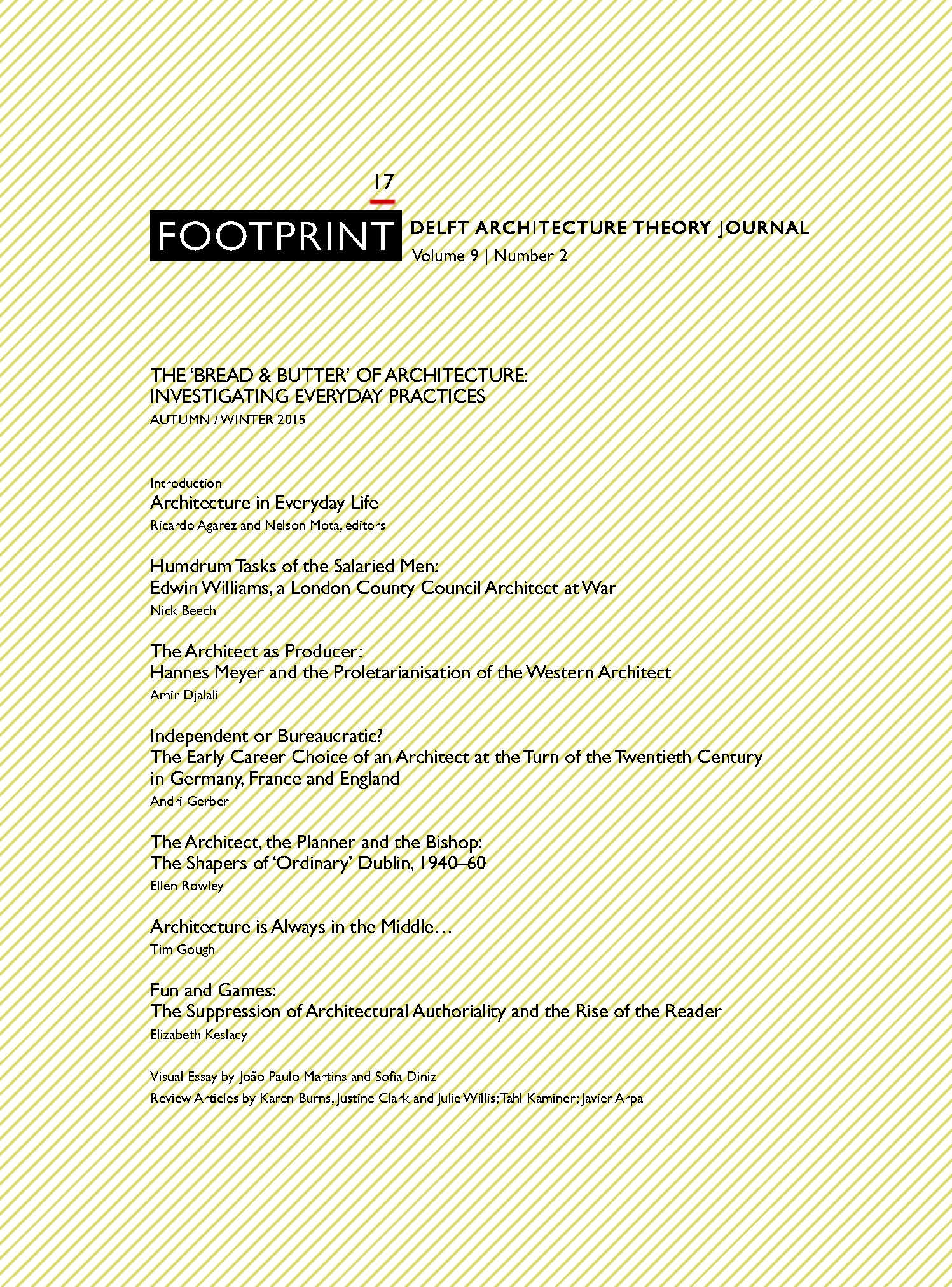Mapping the (Invisible) Salaried Woman Architect: the Australian Parlour Research Project
DOI:
https://doi.org/10.7480/footprint.9.2.872Abstract
Since the 1970s, feminist historians and polemicists have struggled to uncover the ordinary lives of women. They believe that gender ideals and biases are a critical part of the weft and weave of daily life. But the quotidian has been a restricted field in our discipline, often used to define a particular building type rather than the lives of architects. For example, we know little about the workdays of professionals or their labour in the workplace. The architectural office - its daily transactions and everyday culture - remains obscure. Even when represented in histories of the profession, the architectural office is filtered through a top-down lens trained on practice directors. The labour and lives of architecture’s male and female employees is unexplored terrain, but we could begin with the demographics: up to three-quarters of Australian women in architecture are salaried workers, continuing a historical trend. In the past, women generally worked for others. The gendering of salaried architectural workers raises questions about the relationship between gender and office work. Feminist historians and theorists have suggested that the office plays a role in forming gender ideals and practices. This paper endeavours to critically describe the lives and labour of women architects at the office, using survey and interview data from a large-scale Australian research project, publicly known through its website Parlour. This research inquires into gender disadvantage and investigates how gender ideals and norms shape the culture of the architectural workplace. The project’s research questions, evidence and explanations form the basis of this essay. The Parlour project is an ongoing platform for sharing information and research, but it gives particular voice to women’s experience in architecture, an experience largely shaped by salaried employment, studentship and the ownership of small practices.
References
Allan, Judith. ‘Evidence and Silence: Feminism and the Limits of History’. In Feminist Challenges: Social and Political Theory, edited by Carole Pateman and Elizabeth Gross, 173–189. Sydney: Allen and Unwin, 1986.
Bates, Laura. Everyday Sexism. London: Simon & Schuster, 2014.
Burns, Karen. ‘The Elephant in Our Parlour: Everyday Sexism in Architecture’. Accessed 01 July 2015. http://archiparlour.org/the-elephant-in-our-parlour-everyday-sexism-in-architecture.
Caven, Val. ‘Constructing a career: women architects at work’. Career Development International 9 (4/5-2004): 518–531.
Clark, Justine. ‘The Australian Institute of Architects Gender policy’. Accessed 01 July 2015. http://archiparlour.org/australian-institute-of-architects-gender-equity-policy/.
Clark, Justine. ‘Six Myths about Women and Architecture’. Accessed 01 July 2015. http://archiparlour.org/six-myths-about-women-and-architecture/.
Clark, Justine, Julie Connolly, Jillian Matthewson and Naomi Stead. ‘Appendix C: Architects in Australia: A snapshot from the 2011 Census’. Unpublished paper, 2013.
Donk, Wim, van der, Brian D. Loader, Paul G. Nixon, Dieter Rucht, eds. Cyberprotest: New Media, Citizens and Social Movements. London and New York: Routledge, 2004.
Graft-Johnson, Ann, de, Sandra Manley and Clara Greed. ‘Why Do Women Leave Architecture?’. Technical Report. Bristol and London: University of the West of England and Royal Institute of British Architects, 2003.
Fox-Genovese, Elizabeth. ‘Placing Women’s History in History’. New Left Review 133 (1982): 23–28.
Fowler, Bridget and Fiona M. Wilson. ‘Women Architects and their Discontents’. Sociology 38 (1-2004): 101¬–119.
Garwood, Shae. Advocacy Across Borders: NGOs, Anti-Sweatshop Activism and the Global Garment Industry. Sterling, VA: Kumarian Press, 2011.
Gunew, Sneja. ‘Feminist Knowledge: Critique and Construct’. In Feminist Knowledge: Critique and Construct, edited by Sneja Gunew, 30–31. London and New York: Routledge, 2013 (1990).
Joyce, Mary. Digital Activism Decoded: The New Mechanics of Change. New York: International Debate Education Association, 2010.
Lake, Marilyn. Getting Equal: The History of Australian Feminism. Sydney: Allen and Unwin, 1999.
Lu, Shu-Ling and Martin Sexton. ‘Career Journeys and Turning Points of Senior Female Managers in Small Construction Firms’. Construction Management and Economics 28 (2010): 125–139.
Navickas, Katrina. ‘What happened to class? New histories of labour and collective action in Britain’. Social History 36 (2-2011): 192–204.
Matthewson Gill, Kirsty Volz and Naomi Stead. ‘Appendix A: Women’s Involvement in the Australian Architecture Profession: Building a clearer and more inclusive picture’. Unpublished paper, 2013.
Matthewson, Gill. ‘Updating the numbers, part 1: at school’. Accessed 01 July 2015. http://archiparlour.org/updating-the-numbers-at-school/.
———. ‘Updating the numbers, part 2: at work’. Accessed 01 July 2015. http://archiparlour.org/updating-the-numbers-part-2-at-work/.
———. ‘Updating the numbers, part 3: Institute membership’. Accessed 01 July 2015. http://archiparlour.org/updating-the-numbers-part-3-institute-membership.
Matthewson, Gill and Justine Clark. ‘The “half-life” of women architects’. Accessed 01 July 2015. http://archiparlour.org/the-half-life-of-women-architects/.
Royal Architectural Institute of Canada. Consultations & Roundtables on Women in Architecture in Canada. Assembled by Eva Matsuzaki with assistance from Patricia Gibb and Imbi Harding, 2003.
Spaeth, Mary Shepard and Katarzyna Kosmala. ‘Identification through Disidentification: A Life Course Perspective on Professional Belonging’. Architectural Theory Review 17 (2/3-2012): 216–233.
Scott, Joan. ‘Feminism’s History’. Journal of Women’s History 16 (2-2004): 10–29.
Torre, Susannah, ed. Women in American Architecture: A Historic and Contemporary Perspective. New York: Whitney Library of Design, 1977.
Walker, Lynne. ‘Women in Architecture (1671–1951)’. In Women Architects: Their Work, edited by Lynne Walker, 7–28. London: Sorella Press, 1984.
Walker, Lynne. ‘The Entry of Women into the Architectural Profession in Britain’. Woman's Art Journal 7 (1-1986): 13–18.
Walker, Lynne. ‘Women and Architecture’. In A View from the Interior: Feminism, Women and Design, edited by J. Attfield & P. Kirkham, 90–105. London: The Women's Press, 1989.
Valian, Virginia. ‘Sex, Schemas, and Success: What’s Keeping Women Back?’. Academe 84 (5-1998): 50–55.
Valian, Virginia. ‘Beyond Gender Schemas: Improving the Advancement of Women in Academia’, Hypatia 20 (3-2005): 198–213.
Downloads
Published
Issue
Section
License
- Authors retain copyright and grant the journal right of first publication with the work simultaneously licensed under a Creative Commons Attribution License that allows others to share the work with an acknowledgement of the work's authorship and initial publication in this journal.
- Authors are able to enter into separate, additional contractual arrangements for the non-exclusive distribution of the journal's published version of the work (e.g., post it to an institutional repository or publish it in a book), with an acknowledgement of its initial publication in this journal.




